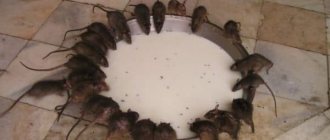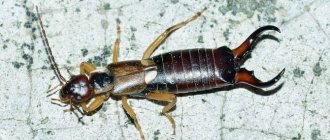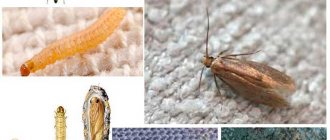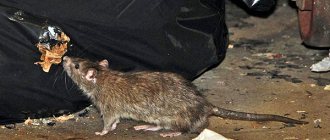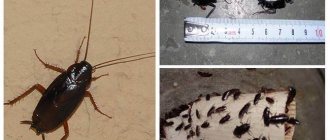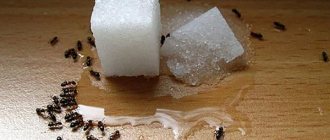The barely audible squeak of a rat, torn bags and spoiled food - such signs of rodents in the house are familiar to many people. It is unlikely that anyone will like such a neighborhood. After all, new roommates are considered not only a symbol of dirt and harm, but also danger, because rats are carriers of many infections. There are many different chemicals available to kill pests. However, a safer method of getting rid of parasites is to scare them away using folk remedies based on what rats and mice are afraid of.
It is known that the smell can quickly drive away pests. Therefore, many people use folk remedies for this purpose. Knowing what grass mice and rats are afraid of, you can get rid of them in a very short time.
Ratcatcher
Rathorn (black root) is one of the most famous plants, the smell of which is not tolerated by mice and rats. Black root against rats and mice is used both fresh and dry. Powdered dry roots, a strong decoction of them, and plant juice are used as a poisonous component for preparing food baits.
Rodents will also not appear in a room where fresh or dry rat grass is laid out. However, due to the large number of dangerous alkaloids, the plant is not recommended for use in apartments or residential buildings. Therefore, when working with it, it is necessary to use a respirator and rubber gloves.
On a note!
It's not just the smell of rat exterminator that scares away animals. What mice and rats fear most is the seed of the plant, which clings firmly to their fur. You can protect animals’ access to the area by planting several blackroot seedlings near the house and outbuildings.
Plants from rats
The smell of rats in residential buildings and apartments
It is not recommended to use poisonous plants with a strong odor in residential areas, but it is not prohibited either. You can place black root, wild rosemary or elderberry in the corners of the house if you are 100% sure that no one except rats will touch it.
If you have pets and small children, you can use safer plants, but no less effective.
- Peppermint;
- Pharmaceutical camomile;
- Tansy;
- Sagebrush;
- Pyrethrum.
You can use the scent of one plant or use a collection of herbs. It is necessary to collect the grass in bunches and place them in the corners of the room, near the expected habitats of rodents. Peppermint and chamomile will create an aromatic aura in the house, which has a beneficial effect on the nervous system of humans and animals. And for rats this smell of herbs is intolerable. Bunches can be arranged in any quantity. It's okay if children touch them or pets smell them.
But you need to be more careful with tansy and wormwood. The plant contains poison, although not as strong as in wild rosemary or wild rosemary. And its strong smell causes headaches, dizziness, weakness, and nausea. The rat reacts more sharply to smell. For a person it will be barely perceptible, for a rodent it will be intolerable. There is no need to lay out a lot of bunches of wormwood and tansy. You just need to update them periodically.
Pyrethrum is considered effective against rats and safe for humans. The smell of this plant is used in the fight against many harmful insects, and is also effective against rats. You can also use the flowers themselves.
If the threat of rat invasion occurs periodically, you can plant the plant in a pot. Then you won’t have to constantly collect fresh rodent repellent.
The smell of essential oil from rats
It is recommended to use plant essential oil as a rodent repellent. The concentration of the odor is much stronger and remains on the surface longer. You can use the essential oil of the above plants. There are several ways to saturate a room with the smell of rodents:
Place a few drops of oil on napkins or cloths. You can use anything that absorbs odor. Place it in the corners of the room, in places where rats like to be.
Add essential oil to the water when cleaning. Clean floors and furniture. The smell will remain for a long time throughout the room. The main task is not to overdo it with concentration. Since it will be impossible for the residents themselves to be in the house.
Drop essential oil onto the candle, then light it. The smell will spread throughout the house gradually and evenly. And along with the smoke it will penetrate into any cracks. Instead of a candle, you can use a night light or lamp. When the bulb heats up, the smell will evaporate.
The cost of essential oil is quite high, but using this product is much more convenient than plants.
Chamomile
Another pest-repellent plant is the beloved chamomile. Its healing and repellent properties have been known to people since ancient times. Long-tailed animals left the hut, on the floor of which fragrant chamomile inflorescences were scattered. Bunches of dried inflorescences helped preserve food stored in outbuildings.
A decoction of the plant was also used to protect the house from gnawing mammals. To prepare it you need 3 tbsp. l. fresh or dry raw materials, pour 1 liter of water and boil for 10 minutes. The resulting decoction was used to treat kitchen furniture, as well as the favorite places of parasites.
A remedy for mice in the house that will keep them away forever. Effective means of control
The most effective remedy for mice is a toxic chemical poison. Various chemical aerosols, poisons, and baits are sold. Such products have significant toxicity and are developed by specialists to kill pests. A lot of pesticides are designed to get rid of mice in a private home.
Chemicals for rodent control are produced in the form of powders, briquettes, and gel. The mouse does not tolerate such poison well. Therefore, in the event of mass poisoning, the mice will certainly leave the house or their population will decrease significantly.
Other methods will also help in solving the problem. For a long time, people have been getting rid of mice using various homemade tricks. Everyone knows traditional mousetraps, as well as folk remedies.
Mousetraps
A mouse can live inside not only a private house, but also an apartment. Sometimes a traditional wooden mousetrap becomes a real salvation for household members. These mice control products must be placed near the burrow or along the path of the rodent.
The design of the mousetrap is not complicated - the pest reaches for the bait, and the mousetrap slams shut. People have long used a similar remedy to fight mice.
There are several nuances to consider:
- No need to put food in the mousetrap right away. The mouse must get used to the new object and consider it not dangerous.
- The location needs to be changed periodically.
Some modern mouse repellents have infrared sensors. When a mouse gets into the trap, the pipe opening slams shut.
Homemade traps
When the use of poisons is undesirable, installing a special trap for rodents becomes a real salvation. There are different designs for catching mice.
In fact, a trap is the best way to keep mice out. Purchasing a modern design from a store can be costly. The device is easy to make yourself. The simple design is effective and catches the mouse perfectly.
Note! Most traps are designed to catch only one rodent.
You will need a piece of cheese as bait. The animals also love pieces of bread. You should drip a little sunflower oil onto the bread. The animals will also like the aroma of a piece of lard. This product can also be used as an effective bait.
The first trap model is the simplest and most effective. The advantages of this mouse repellent are the ability to replace one element with another.
You will need:
- pot;
- ruler;
- spoke.
The pan can be replaced with a bucket, the knitting needle with metal wire, and the ruler with a slats. We choose a knitting needle or wire that is rigid and strong.
Next, glue the knitting needle to the ruler. She will be a support. Both ends should rest against the bucket. We rest one end of the ruler on the edge of a pan or bucket, leaving the other end hanging.
We place bait on it that the mouse loves. To get a treat, the mouse must climb onto the ruler, so we place the bucket in the place where the rodent has settled. The container should be filled one third with water.
The whole design is very simple:
- the mouse begins to be attracted by the smell of the bait.
- The rodent climbs onto the ruler, causing the center of gravity at the intersection of the rod and the knitting needle to shift.
- When the mouse moves along the ruler, the freely overhanging part of the ruler is lowered.
- The rodent falls into a container of water.
Another model for catching a mouse is made according to a similar principle. To make the mouse rise to the top of the can, we install a rack.
A treat for the animal is placed inside a glass container. We tighten the neck of the container with paper cut crosswise. You can use a blade for this purpose.
Trap action:
- the rodent gets to the top of the jar.
- The paper petals bend inward.
- The mouse falls into the jar.
You can put the bait directly on the paper. But sometimes the mouse gets scared of the paper and won’t climb on it. Then alternative traps should be used.
The third version of the homemade design is also simple. To catch a mouse you will need a coin or a large button, as well as a pan. The coin serves as a support and is attached to one edge of the container. It needs to be raised a little.
Next, take a strong thread and attach a hook to it. We install a wire inside the container. We throw a thread with a hook onto this rod and put on the bait.
Design action:
- to get the bait, the mouse pulls the thread and the hook with the bait.
- The thread is very stretched.
- The support is pulled out from under the container.
- The mouse gets trapped and cannot get out.
7 RAT TRAPS - Best Homemade Traps
You can catch one mouse using the design. In addition to the thread, you can simply glue the bait to the wall of the container. To get to the food, the rodent will swing the jar and knock out the support.
There are modern self-loading designs that do not need to be constantly monitored. If the owner of the house is going to leave, then it is better to install just such a trap. It is designed to catch several animals.
Essential oils
Rodent control products
Another pest repellent is essential oils. Their concentrated odors are not liked by rats and mice. It is enough to place an oil-soaked swab or a piece of cloth next to the rodent's hole, which will smell strongly, and the mouse family will no longer live there.
Essential oils should be used with extreme caution, as their concentrated odor can cause an allergic reaction.
On a note!
Plants against pests are used quite widely. However, rodents are repelled not only by herbal aromas. The smell of kerosene, burnt rubber and even perfume products is also detrimental to parasites. However, most of them are preferable for use in non-residential premises.
How to use scents to repel
- Peppermint for mice is quite effective. The pleasant mint aroma for humans is intolerable for small animals. If you spread dried mint leaves throughout the room, the mice will soon leave it. In addition to the sprigs, you can use more concentrated mint oil. It is enough to pour a few drops onto a cotton swab and place them in the mouse’s favorite places.
- The essential oil of marsh rosemary contains substances that have a toxic effect on mice. Mice do not like such smells and try to stay away from their source.
- The bitter smell of wormwood causes a severe allergic reaction in many people. This plant has a negative effect on animals. The most effective way to get rid of rodents is by fumigating the premises with a smoldering plant. This method is suitable for repelling mice in utility rooms in a country house or in a private house.
- Mice cannot tolerate the smell of citrus fruits. Orange peels can be a good animal repeller. It is enough to cut the peel from one or several oranges and dry it in the oven or in the open air. Then place the dried pieces of zest in food cupboards. A pleasant citrus aroma will prevent pest invasion.
- The strong smells of spices such as pepper, cinnamon, coriander, and cloves also help remove mice.
- The aromas of many herbs and medicinal plants cause fear among pests and act as a natural repellent. Such herbs against mice include: cilantro, chamomile, tansy, and black root. By placing branches of plants throughout the house, you can drive away uninvited guests for a long time.
- Garlic, with its pungent odor, can discourage rodents from visiting your home for a long time. By placing garlic cloves in cabinets and in cracks between building ceilings, you can reliably protect your home from mice. But do not forget that after this procedure the house will smell of garlic for a long time, which may be unpleasant for the residents.
- Vinegar helps get rid of mice in a very short time. Scraps of fabric soaked in acetic acid must be placed in areas where rodents appear. After this procedure, they will leave this room for a long time. But it is necessary to take into account that not all household members can tolerate the smell of vinegar.
- To eliminate pests in non-residential premises, you can use products with very unpleasant odors. Tailed animals will not be delighted with the smell of tar, burnt rubber, kerosene or mothballs.
The use of various plants, rubber, wool, kerosene and other similar substances does not kill rodents, but only forces them to leave their habitable places. However, when choosing which smell mice dislike the most, do not forget about those who live indoors.
After all, most of them are no less dangerous for humans. Therefore, when using wild herbs, you need to take precautions. Most of them are poisonous and inhaling their aroma or touching them with unprotected hands can cause poisoning or an allergic reaction.
Only by following the rules can you achieve a positive effect without harming yourself. Which methods will be most effective for your property depends on various reasons.
In addition to the fact that pests spoil furniture and food in the house, they emit a specific unpleasant odor that is absorbed into clothes, carpets, and bed linen. The occurrence of such a stench is explained by the fact that excrement contains a large amount of ammonia, which penetrates into any material and is practically not excreted. The following instructions will help you say goodbye to the stench:
- First of all, get rid of pests.
- Do a general cleaning of all rooms of the apartment, sweep and throw away mouse excrement.
- Rinse all surfaces and places where mice were located by dissolving 5-6 tablespoons of vinegar in 5 liters of water.
- Use air fresheners and antibacterial solutions that absorb mouse excrement odors.
- After the surface has dried from the vinegar solution, treat it with hydrogen peroxide.
dead mouse
If mice were removed from the apartment using poisons, then there is a chance that they died in their holes and emit a terrible smell. Two or three dead mice will not cause harm to a person; their smell will quickly disappear. The stench from several rodents can cause irreparable harm to humans. The smell of a corpse acts like poison on people. In order to get rid of such a stench, it is necessary to find and eliminate all rodent corpses.
DETAILS: Viburnum seeds beneficial properties and contraindications. Medicinal properties of red viburnum seeds and contraindications
Very simple and affordable “repellers” can be added to this category:
- Mint;
- Sagebrush;
- Pharmaceutical chamomile;
- Tansy;
- Elder.
These plants have a very strong odor that rodents do not like. If you place fresh or dry bunches around the house, the mice will soon leave. If you don’t have plants on hand, use cotton wool soaked in appropriate essential oils.
A good out-of-season method is cilantro. Fresh herbs can be bought at almost any market. It should be laid out near the intended place of residence of the mouse and changed as it dries.
In the kitchen, you can use coriander against mice: rodents also do not like its smell. The spice can be placed in drawers and shelves with products.
There are other smells that mice don't like. These are naphthalene, tar, burnt rubber, kerosene. They can be used in technical rooms: garages, basements. You can also use bleach, vinegar, and ammonia to repel mice.
If you have a product made of natural fur or a pet, take some wool and set it on fire. This smell signals to mice a great danger: fire. Rodents prefer to leave the room where they smell this smell.
It should be remembered: pests can get used to odors, so it is recommended to alternate them.
What else are pests afraid of?
The question of what smell repels rats and mice is puzzled by those who, for one reason or another, cannot use chemicals.
- Bleaching. The smell of this substance is actually avoided by mice and rats. However, one should also take into account the fact that when using this product in a residential area, the inhabitants of the home themselves will have to inhale its aromas.
- Vinegar. Has properties similar to bleach. Inhaling its vapors is also unsafe for humans.
- Naphthalene is a strong carcinogen, and therefore experts do not recommend using it in residential areas.
Plants against mice
When you set fire to rubber and spray kerosene, you yourself are forced to put on protective equipment. And if you are not ready for such a fight, then you can use a more human-friendly method by turning to poisonous plants for help.
What smell repels mice is the one that the following plants have:
- Elder
- Ledum
- Blackroot.
Why they are afraid of these particular scents is explained by their ability to instinctively sense danger. And it really comes from these plants. Thus, essential oils of wild rosemary and hydrocyanic acid contained in elderberries are dangerous for all animals and even humans.
And black root, in addition to an unpleasant aroma for animals, also has prickly seeds that dig firmly into the skin of rodents, causing unpleasant sensations. People who decide to use this plant against mice should be careful, since the poison is contained in all its parts.
The best way to use herbs is as follows. After dipping the twigs in boiling water, they are laid out near the burrows and in places where rodents are most concentrated. By changing them once a week, you can keep pests away from your home forever. But if you decide to use wild rosemary or black root, you need to be sure that children or pets will not get to it.
And if these are present in your home, then it is better to take less poisonous repellent plants:
- Tansy
- Pyrethrum
- pharmaceutical camomile
- Sagebrush.
Dried branches of these herbs can be hung around the house, periodically updating the bouquets. They are completely safe for homeowners, but rodents don’t like the way they smell.
Garden plants in the fight against rodents
Among the natural repellents grown by a person in his garden, peppermint has a repellent effect. It can be used either fresh or in the form of a solution or concentrate. Essential oil made from this plant also gives a good effect.
Fresh bunches of grass placed in the path of rats and mice will force them to leave your home. In addition, they are absolutely safe for humans. At the same time, essential oil must be applied carefully so as not to run away from the apartment yourself, and faster than mice.
Useful video: Mice in the house, how to get rid of them
Does light work on rats?
The question of whether mice are afraid of light worries many. Many people believe that leaving the lights on at night will prevent animals from bothering them. However, this statement is not entirely true. Some individuals are really frightened by the light: they squint and try to hide as quickly as possible. But there are also representatives who quickly adapt to bright lighting, after which it does not serve as an obstacle to them at all.
Pest Control
What kind of insulation is not damaged by rodents?
If mice bypass something with their attention and do not try to taste it, this means that they do not like the taste or smell, or they are simply not able to chew such an object.
You should choose a good insulation for walls based on the above parameters. For example, they correspond to:
- Foam glass and foam ceramics - these materials are so hard that the jaws of mice simply slide across the surface.
- Foam and aerated concrete are also quite hard. Mice can gnaw through them only in exceptional cases (for example, when technological errors were made during the preparation of concrete that affected the characteristics of the finished product).
- Expanded clay - being a bulk material, it creates inconvenience for rodents and does not allow them to move inside the insulating layer. In addition, it is very hard. Mice will neither sharpen their teeth on it nor create nests inside it.
- Ecowool and cellulose-based insulation - thanks to special processing, they become toxic to rodents. Most often they are impregnated with borax.
- Insulation made from flax fibers - they contain a substance called lignin, known for its repellent effect.
For greater reliability, the insulation must be treated with special sprays, which are sold in hardware stores and are designed to combat rodents. But they have two significant drawbacks - a short period of validity (from two weeks to a month) and an extremely unpleasant odor, which makes it impossible to use them in residential premises.
Are rodents afraid of water?
Neither mice nor rats are afraid of water, as they are able to stand on it perfectly. Gnawing creatures swim no worse than their aquatic counterparts, however, at every opportunity they strive to get onto land as quickly as possible. The exception is water rats and other types of rodents that settle along the banks of reservoirs.
Therefore, when deciding to get rid of rodents using water traps, it is necessary that their internal walls are smooth and slippery. Once caught in such a water trap, the animal will not be able to get out of it.
Are mice afraid of cats?
They say that the most reliable way to get rid of mice in the house is to get a cat. Even if he turns out to be a lazy furry lump and refuses to hunt rodents, they, having smelled his scent, will become more careful and prefer to change their place of residence.
The authors of the site VredStop.ru authoritatively assert: this is nothing more than a myth. Firstly, cats and cats do not have a specific smell. They constantly lick their fur - and they do this not because they have nothing else to do, but precisely in order not to smell. Initially, such a mechanism was developed in the process of evolution as a guarantee of successful hunting, because the less noticeable the predator, the higher the likelihood that the prey will not be able to escape from it. The habit continues even now, even among those animals that hunt only the owner’s legs or a toy fishing rod. And secondly, mice are quite brave and smart animals. If they see that the cat is not interested in catching rodents for dinner, they can run in front of his very nose and even calmly steal food from his bowl.
To drive mice out of the house, it is better to use not traditional methods, but products specially developed by biologists and chemists. All other methods give only short-term and unnoticeable results.
AfterText #1
Who are pests afraid of?
Not all rodents are afraid of cats. The exception in this case is large pasyuki or gray rats. Many of them are able to move freely in broad daylight, without paying much attention to the mustachioed pet sitting next to them. However, there are also brave cats who are not afraid to attack uninvited guests. The dog easily attacks a large rat.
On a note!
The cat will provide invaluable service in catching small parasites. Rodents are very afraid of even the cat smell that is present in the apartment. Having cleared the house of pests, many mustachioed predators go hunting in neighboring areas. Mice and rats are no less afraid of birds.
Rats versus mice are also a common occurrence in nature. Where large rodents have settled, small ones will never appear. After all, a hungry rat poses a serious danger to a little mouse. Rodents are also afraid of people, but in some cases rats can attack humans.
Description and reasons for appearance
Human homes are subject to rodent invasion both in the cold season and in the heat. The main task of the colony is to find food and procreate. If one female gets into the house, then in a month there will already be twenty young individuals in the room, ready to breed. They are undemanding to the quality of food and eat everything that comes into their field of vision.
To know what repels rats, it is important to understand why they appear in this particular house. There are reasons that contribute to this “neighborhood”:
- Garbage bins. Animals go where it is easiest to get food. From compost pits, garbage dumps and tanks, they move to humans.
- Unharvested harvest. Fallen fruits in the garden and leftover vegetables on the plot will make an ideal dining room.
Rats have an excellent sense of smell, which is why they sense the presence of food in the house. - Sheds with livestock and storage facilities for raw materials. The buildings are warm and have food, so uninvited guests will feel comfortable.
Animals also penetrate into multi-storey buildings, getting from basements to apartments through ventilation and sewerage. With powerful teeth they destroy any obstacle except glass and metal. A small hole in the wall quickly turns into a huge door for landing troops to penetrate.
Rodents are carriers of dangerous diseases such as:
- typhus;
- salmonellosis;
- plague;
- tularemia.
In the first days, it is difficult to detect the presence of “neighbors,” but as the colony grows, squeaking, quiet grinding and stomping can be heard. An unpleasant odor and black shiny excrement appear in the room. If you look closely at the walls of the pantry, kitchen and bathroom, you can easily notice holes. Sometimes lumps of paper and pieces of rags are found around the house, and bags of cereals are always chewed through.
In this video you will learn how to drive rats out of your home:
Do mammals respond to sound?
Oddly enough, rats and mice are very scared of loud noises. Animals will not live in a house where music is playing loudly, or a drill or other power tool is running.
Another way to repel tailed pests is with ultrasonic devices. High cost is their main drawback. Pests cannot withstand the ultrasound generated by the device, so they rush to leave the room as soon as possible. These sound waves are not perceived by the human ear, and therefore are completely safe for health.
To obtain the desired result, it is important to choose the right ultrasonic rodent repeller. Its power must correspond to the area of the room. Otherwise, it will not be possible to get rid of rodents. An equally important nuance is the ability to change the frequency of the signal, since the same sound can cause addiction in parasites.
Ultrasound and methods of its application
Rats and mice hear sound with a frequency of up to 80-100 kHz, while humans are no longer practically unable to perceive vibrations with a frequency above 20 kHz. Sound with a frequency above 20 kHz is called ultrasound, and it meets one of the requirements for rodent repellents - to affect rats and mice without affecting humans.
It has been verified that devices that emit sound waves with frequencies from 20 kHz to 70 kHz can indeed repel rats quite effectively. In this case, an effective repeller must not only generate ultrasound, but also have a number of other important characteristics.
Here are the most significant of them:
- High sound pressure (a parameter similar to volume, but in the ultrasonic range). The higher the sound pressure, the higher the likelihood that rats will not tolerate the sounds produced by the device and will leave the area;
- The wide directional pattern of emitted ultrasound determines in which direction and how widely the sound travels. Ideally, it should approach 360°, that is, in fact, ultrasound in this case will spread evenly around the entire repeller. Most devices claim this angle, but in fact their ultrasonic radiation pattern barely reaches 50°;
- Automatically changing ultrasonic frequency. It is important to understand that not all ultrasound scares rats. Just as not every sound causes discomfort in humans, not every ultrasound repels rodents. But if the device constantly changes the frequency of the emitted ultrasound, then periodic discomfort will not be avoided for rodents.
The most effective ultrasonic repellers against rats today include Biostrazh, Chiston 2, Chiston 2 PRO, Tornado 800, TM-315 and some others. They are also one of the most expensive. More affordable devices are not as powerful, and some of the cheapest ones are outright junk, useless and not at all capable of scaring rats.
In addition, rats can get used to ultrasound, just like any other sounds. This, although rare, does happen. In this situation, pests may leave the room at first when the device is turned on, but then they will return again.
It is also useful to read: Remedies against rats and mice and the nuances of their use at home
Ultrasonic repellers, when used correctly, do not have a negative effect on people, but may cause headaches for some. It should also be taken into account that cats and dogs hear ultrasound well, especially domestic mice, rats and hamsters, and therefore if there are pets in the house, such a device may not be able to be used.
At the same time, a cat itself, and sometimes a dog, is often a much more effective “repellent” of rats and mice...
What are rats afraid of in the house?
How to get rid of rats in the house? Humans' struggle with rodents has lasted for many centuries, so humanity has figured out what poses a threat to parasites. There are many natural and ready-made products that repel rodents. In most cases, such devices, herbs, and oils completely eliminate parasites. If this does not happen, use homemade rat traps and insecticides.

